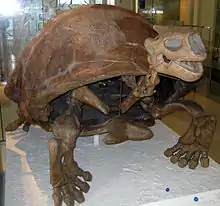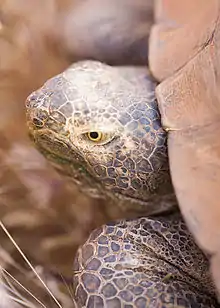Megalochelys atlas
Megalochelys atlas is an extinct species of giant cryptodiran tortoise from the Late Miocene[2] through to the Early Pleistocene[3] periods. During the dry glacial periods it ranged from western India and Pakistan (possibly even as far west as southern and eastern Europe) to as far east as Sulawesi and Timor in Indonesia, though the island specimens likely represent distinct species.[4] It has been suggested that Megalochelys sivalensis is the correct name for the taxon,[5] though this is disputed.[4]
| Megalochelys atlas | |
|---|---|
 | |
| Skeleton at the American Museum of Natural History | |
| Scientific classification | |
| Kingdom: | Animalia |
| Phylum: | Chordata |
| Class: | Reptilia |
| Order: | Testudines |
| Suborder: | Cryptodira |
| Superfamily: | Testudinoidea |
| Family: | Testudinidae |
| Genus: | †Megalochelys |
| Species: | †M. atlas |
| Binomial name | |
| †Megalochelys atlas | |
| Synonyms | |
Description
Megalochelys atlas is the largest known member of the Testudinidae, with a shell length of about 2.1 m (6.9 ft), an estimated total length of 2.5 to 2.7 m (8.2 to 8.9 ft), and an approximate total height of 1.8 m (5.9 ft). Popular weight estimates for this taxon have varied greatly with the highest estimates reaching up to 4,000 kg (8,800 lb) in some instances.[6] However, weights based on volumetric displacement of the skeleton,[7] or inferences based on two-dimensional skeletal drawings,[8] indicate that M. atlas was probably closer to 1,000 to 2,000 kg (2,200 to 4,400 lb) in mass. M. atlas is thus the largest known tortoise. The only larger turtles were the marine Archelon and Protostega from the Cretaceous Period, and the aquatic, freshwater Stupendemys of the South American Late Miocene.

Like the modern Galápagos tortoise, M. atlas' weight was supported by four elephantine feet. Since most members of the related genus Testudo are herbivores, paleontologists believe M. atlas had the same diet.
Taxonomy
Megalochelys atlas has a complicated nomenclatural history. It has previously been placed in the genus Colossochelys, however this name is in fact a junior synonym of Megalochelys, the statement of withdrawn by Auffenberg (1974).[9] Hence the correct genus is Megalochelys and the correct species is M. atlas.
Extinction
It is widely suspected that the species went extinct due to the arrival of Homo erectus, due to staggered extinctions on islands co-inciding with the arrival of H. erectus in these regions.[4]
References
- Falconer, H. and Cautley, P.T. 1844. Communication on the Colossochelys atlas, a fossil tortoise of enormous size from the Tertiary strata of the Siwalk Hills in the north of India. Proceedings of the Zoological Society of London 1844(12):54–84.
- "Colossochelys atlas". Paleobiology Database. Retrieved 2012-03-02.
- Hansen, D. M.; Donlan, C. J.; Griffiths, C. J.; Campbell, K. J. (April 2010). "Ecological history and latent conservation potential: large and giant tortoises as a model for taxon substitutions" (PDF). Ecography. Wiley. 33 (2): 272–284. doi:10.1111/j.1600-0587.2010.06305.x. Retrieved 2011-02-26.
- Rhodin, Anders; Pritchard, Peter; van Dijk, Peter Paul; Saumure, Raymond; Buhlmann, Kurt; Iverson, John; Mittermeier, Russell, eds. (2015-04-16). Conservation Biology of Freshwater Turtles and Tortoises. Chelonian Research Monographs. 5 (First ed.). Chelonian Research Foundation. doi:10.3854/crm.5.000e.fossil.checklist.v1.2015. ISBN 978-0-9653540-9-7.
- Vlachos, Evangelos (2019-08-30). "On the nomenclature of the largest tortoise that ever lived: Megalochelys sivalensis Falconer & Cautley, 1837 vs. Colossochelys atlas Falconer & Cautley, 1844 (Reptilia, Testudinidae)". The Bulletin of Zoological Nomenclature. 76 (1): 162. doi:10.21805/bzn.v76.a050. ISSN 0007-5167.
- Orenstein, R. 2001. Survivors in Armor: Turtles, Tortoises, and Terrapins. Key Porter Books Ltd.
- Brown, B. 1931. The Largest Known Land Tortoise. Nat. Hist. Vol. 31:184–187.
- Paul, G.S., and Leahy, G.D. (1994). Terramegathermy in the time of the titans: Restoring the metabolics of colossal dinosaurs. Paleontol. Soc. Spec. Publ. 7, 177-198
- Auffenberg, Walter (1974). Checklist of fossil land tortoises (Testudinidae). Bulletin of the Florida State Museum, Biological sciences. 18. University of Florida. p. 173. OCLC 1532640. Retrieved 2012-03-02.
